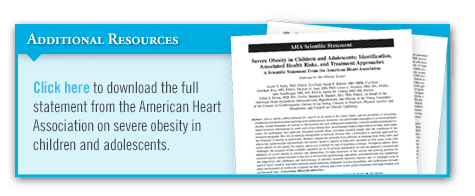Recent data suggest that overall rates of obesity among children and adolescents have slowed, but worrisome trends have emerged in the form of severe pediatric obesity. “Severe obesity is the fastest-growing subcategory of obesity in children and adolescents, affecting 4% to 6% of all youths in the United States,” says Aaron S. Kelly, PhD. Severe obesity in childhood has both immediate and long-term health consequences, including a greater risk for adverse cardiometabolic risk factors and earlier signs of vascular dysfunction and subclinical atherosclerosis.
High BMI and adiposity levels in childhood have been associated with a higher risk of cardiovascular disease (CVD), diabetes, and premature death. “Unfortunately,” says Dr. Kelly, “many of the treatment approaches commonly used in overweight and obese youths are less effective for cases in which severe obesity is present. Treatment options for children with severe obesity are limited, and most standard approaches to weight loss are insufficient for them. Novel treatment strategies must be tailored for severe obesity in order to alter the health trajectory of children and adolescents afflicted with this disease.”
Defining Severe Obesity
To begin addressing the challenges of managing this patient population, the American Heart Association (AHA) published a scientific statement in Circulation. “A key component of the statement was to develop a standardized definition of severe obesity in children and adolescents,” says Dr. Kelly, who co-chaired the AHA writing group’s scientific statement. The statement defines children older than 2 (and adolescents) as severely obese if they either have a BMI that is at least 20% higher than the 95th percentile for their gender and age, or a BMI of 35 kg/m2 or higher.
Using the AHA’s recommended definition, about 5% of children and teens in the U.S. are classified as severely obese. “This definition of severe obesity should be used consistently in clinical and research settings to standardize our efforts to better characterize the disease,” Dr. Kelly says. “It will also help us better evaluate novel approaches for managing and treating this patient group.”
A Step-Wise Approach to Treatment
According to the AHA, a step-wise approach is necessary for treating severely obese children, with treatments gradually being intensified from lifestyle changes to medication and, if necessary, surgery. “The foundation of treatment for severe obesity for youths is lifestyle modification,” says Dr. Kelly. “Regular physical activity, a healthy diet, and behavior counseling are all important components to lifestyle that need to be addressed. Although conventional strategies have been shown to modestly improve BMI, children and adolescents tend to remain severely obese after concluding such treatment programs, and many regain weight. As such, interventions need to be tailored to each patient based on their unique characteristics.”
“Novel treatment strategies must be tailored for severe obesity in order to alter the health trajectory of children and adolescents afflicted with this disease.”
The role of medical management for severe obesity in adolescents is minimal because only one medication is currently approved by the FDA. In fact, some clinicians will prescribe medications that are off label or have poor safety and efficacy data in order to treat severe obesity. “Fortunately, the obesity medication pipeline is strong for adults,” Dr. Kelly says (Table 1). “Once new medications are approved by the FDA, pediatric clinical research trials should be initiated in earnest to further our treatment armamentarium.”
Bariatric surgery has generally been effective in reducing BMI and improving CVD and metabolic risk factors, but there are few reports of long-term outcomes. In addition, many youths with severe obesity do not qualify for surgery or have limited access to it because they lack insurance coverage. “The step from lifestyle changes and medications to surgery is large,” says Dr. Kelly. “While early data are promising, we need more information on the long-term safety and efficacy of weight-loss surgery.” Evidence-based strategies for appropriate patient selection for these procedures
are also needed.
A Call to Action
The AHA statement calls for innovative approaches to fill the gap between lifestyle, medication, and surgery and identifies several strategies for closing these gaps (Table 2). “We need to conduct research on ways to get more youths to engage in lifestyle interventions so that the need for medications and bariatric surgery is minimized,” Dr. Kelly says. “But, we need to be realistic about the limitations of lifestyle therapy in this patient population and engage in research that evaluates drugs, surgery, and medical devices. The AHA has made a call to action to clinicians that we need to recognize severe obesity as a chronic disease that requires ongoing care and management. The task ahead will be challenging, but the prevalence and consequences of severe obesity require us to commit our time, intellect, and financial resources to address it.”




 admin
admin